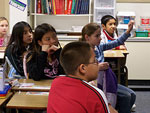Talking History

One of the difficulties of teaching history to English language learners is that their thinking is very often far ahead of their ability to express themselves in English. In building language and historical proficiency in the English language learners at our small middle school, we strive to build a “place of plenty”: we want students so familiar with historical content and particular historical thinking skills before they begin a writing assignment that we can then focus on the structure of the writing, and not struggle with the content. In order to build this place of plenty, we use as many cooperative, interactive activities as possible. We want our classrooms to buzz with content chatter. To do this, we must adapt and use several different structures, from brief mode of response structures to more in-depth seminar formats.
In everyday classroom discussion, we use the following interaction engagement strategies to get students talking history. While some of them are regularly used best practices, the addition of language goals and structures in each one adds value for English language learners, as well as for those students who are learning academic English. 1: Structured Think-Pair-Share As most teachers know, there are many ways to use this tool. In this version, teachers use it to not only help students with historical content, but to become familiar with appropriate historical language as well. For instance: after reading one primary source on the reasons for the Mexican-American war, the teacher asks the class: what is this author’s argument about the main reasons that the U.S. attacked Mexico? The teacher asks students, in pairs, to answer this question using the following frame that is posted on the board:
“This author, ______________, argues that _________________ was the main reason for the U.S. to enter the Mexican-American war because__________________.”
2: Triads The teacher poses a question to the class. For example, is John Brown an American hero? One student is called on to give his or her opinion, and is required to use an academic frame – “I contend that John Brown is/is not an American hero because…” Next, a second student is called on (randomly), and is asked to agree or disagree with the first student. A framework can also help here with language development: “I agree/disagree that John Brown is a hero because…” A third student is then called on to extend or disagree with the second student’s interpretation. Finally, the first student must state if she or he has the same opinion, or if his or her opinion has shifted. When done quickly and thoughtfully, this can be an excellent antidote to the sometimes deadly “class discussion,” and allows students to practice the language of comparing ideas. 3: Rally-Coach In this activity, students pair up. Between them, they have one set of comprehension or reasoning questions, and one pencil. Student A is responsible for answering question 1, but Student B has the pencil; Student A must discuss the answer with Student B. Students talk out issues, and are required to use historical vocabulary both orally and in their writing. During this activity, there are many opportunities for students to say, “Do you mean_________?” which allows students to listen to their own ideas, and rephrase their thoughts.
More extended opportunities for discussion not only require the students to prepare materials to bring to the talk, but allow for different opportunities and contexts for students to become more facile with historical ideas. Here are a few that we’ve found encourage both historical and linguistic mastery. 1: Socratic Seminar A Socratic seminar—with all of the preparation that leads up to it—is a wonderful way to build a rich place of plenty around a specific historical question. Attached are documents to get started on a seminar. Because of the extensive preparation all students have to do and the student-led structure, these seminars have never failed to get even reticent English speakers to use content-area vocabulary and academic syntax. Holding a Socratic Seminar around a controversial historical question—even for students as young as 6th grade—is the perfect preparation for producing rich, meaningful historical position papers. 2: Simulations Simulations like History Alive’s Constitutional Convention and the many in Rethinking Schools allow English language learners to try on different hats, and use content-heavy vocabulary in a meaningful and fun context. When a student “plays a part,” she very often feels freed up to try out academic or unfamiliar language since she is not hearing herself speak it. When we encourage our students to talk and share ideas, and when we give them multiple linguistic tools to do it, we provide the framework upon which students can articulate complex, nuanced historical understandings.
